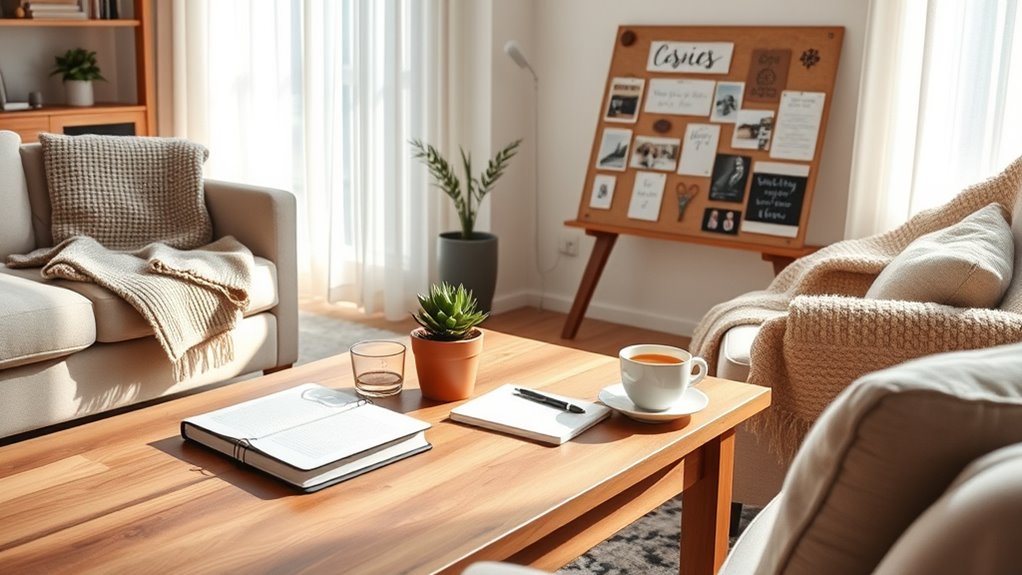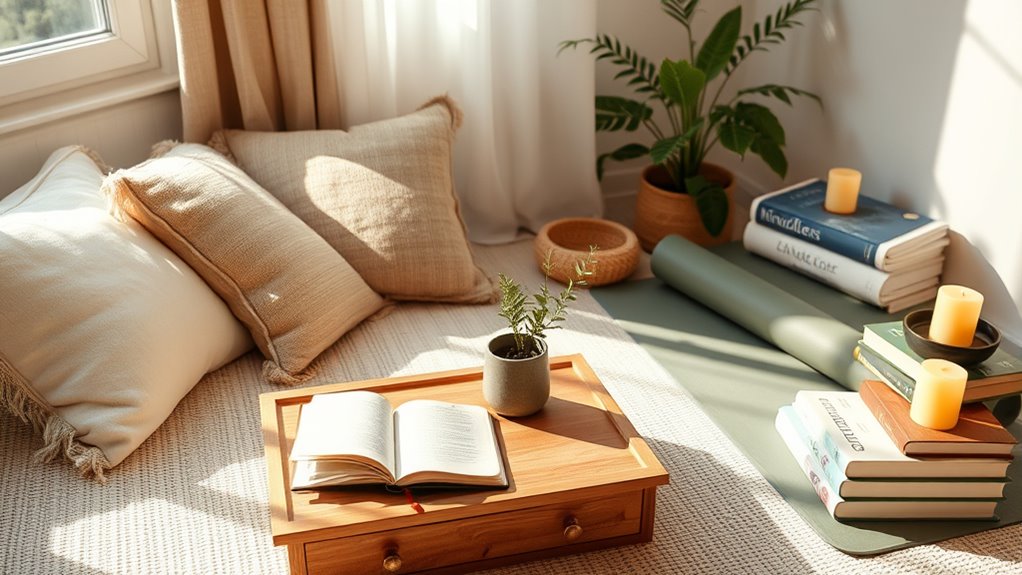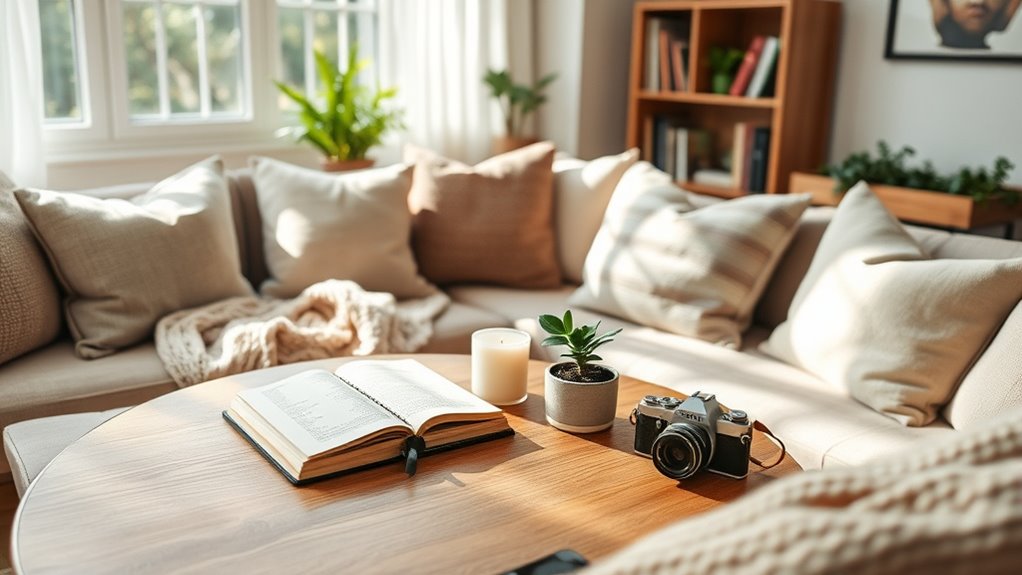To plan a digital detox retreat at home, start by setting clear goals and choosing a time that’s less stressful, like a weekend or holiday. Create a designated tech-free zone and organize relaxing activities such as meditation, journaling, or outdoor walks. Prepare a calming environment with natural elements and set boundaries with family and friends. Keep track of your progress and reflect on your experience to make lasting changes that boost your well-being. If you keep exploring, you’ll find ways to make your retreat even more effective.
Key Takeaways
- Set clear intentions, goals, and realistic targets for reducing screen time and establishing tech-free zones.
- Choose a suitable time with minimal stress and plan the retreat duration based on your objectives.
- Create designated digital-free areas and a peaceful environment with calming décor and natural elements.
- Inform and involve family or friends to support your detox and organize offline activities like outdoor walks and creative hobbies.
- Incorporate mindfulness, relaxation, and creative exercises to enhance presence, reduce stress, and foster mental clarity during the retreat.
Setting Your Intentions and Goals

Before you begin your digital detox retreat, it’s important to clearly define your intentions and goals. Think about why you want to reduce your screen time and establish healthier tech boundaries. Are you seeking more quality time with loved ones, improved focus, or mental clarity? Setting specific objectives helps you stay motivated and on track. Decide which devices or apps you want to limit or avoid entirely, and set realistic targets for your screen time reduction. By clearly outlining your intentions, you create a purpose-driven retreat that guides your actions. This clarity ensures you remain committed to disconnecting and enjoying the benefits of a tech-free environment. Additionally, understanding the importance of setting realistic targets can help you develop a sustainable plan that supports long-term digital wellbeing. Ultimately, well-defined goals set the foundation for a successful and fulfilling digital detox experience.
Choosing the Perfect Time and Duration

Choosing the right time for your digital detox is key to making it successful. Consider periods when your schedule is lighter and less stressful, so you can fully disconnect. Avoid busy or disruptive times to guarantee you get the most benefit from your retreat. Planning ahead and selecting a suitable time frame can help ensure you stick to your goals and maximize relaxation.
Optimal Timing Considerations
Timing your digital detox retreat effectively can make all the difference in gaining lasting benefits. Choose a time when your schedule is relatively light, such as weekends or holidays, to minimize stress and disruption. Aim for a period that allows you to fully disconnect and embrace digital minimalism without feeling rushed. Consider establishing tech free zones during this time—areas in your home where devices are off-limits—to reinforce your commitment. Avoid overlapping your retreat with major deadlines or social events, as these can tempt you to re-engage with devices prematurely. The right timing helps you create a clear boundary, making it easier to focus on reconnecting with yourself and your environment. Proper planning ensures your digital detox is both manageable and meaningful.
Ideal Retreat Length
Finding the right length for your digital detox retreat is essential to make sure you gain meaningful benefits without feeling overwhelmed. A shorter retreat, like a weekend, can help you reset your screen time and reduce social media dependency. Longer stays, such as a week, deepen the experience but require more planning. Consider your schedule, comfort level, and goals when choosing duration. To help, here’s a quick guide:
| Retreat Duration | Recommended Focus | Benefits |
|---|---|---|
| 1-2 days | Light social media reduction | Quick refresh, less screen time |
| 3-4 days | Moderate social media use | Better mental clarity |
| 5+ days | Full digital break, minimal screen | Deep reset, renewed habits |
Select a length that challenges you but is manageable. AI-powered tools can assist in tracking your progress and maintaining accountability during your retreat.
Avoiding Disruptive Periods
Selecting the right time for your digital detox retreat is essential to guarantee it fits seamlessly into your life and minimizes disruptions. Pick a period when social media activity is typically low, or when you’re less likely to receive urgent email notifications. Avoid busy workweeks or times with upcoming deadlines, as these can cause stress and make it harder to disconnect. Planning during weekends or quieter days allows you to fully immerse yourself without feeling overwhelmed. Also, inform colleagues and friends in advance to prevent unexpected messages or notifications. Choosing a time when your routine won’t be disrupted ensures you can truly benefit from your retreat. By avoiding disruptive periods, you create a calm environment that fosters meaningful disconnect and relaxation. Incorporating Gold IRA rollover strategies into your financial planning can also provide peace of mind, knowing your assets are protected during times of change.
Creating a Digital-Free Zone

To truly disconnect, you need to establish a dedicated digital-free zone in your home where devices are off-limits. Creating tech free zones helps you set clear boundaries, making it easier to resist the urge to check your phone or laptop. Designate specific areas, like a cozy corner or a dining space, where no screens are allowed. These device free zones become your sanctuary for relaxation and presence. Keep these zones inviting and comfortable, encouraging you to spend time without digital distractions. By intentionally setting up spaces free of technology, you reinforce your commitment to a digital detox. Incorporating celebrity lifestyle insights can also inspire you to create personalized and stylish retreats that support your goals. This simple step helps you reclaim your space, reduce temptation, and foster genuine connections with those around you.
Planning Relaxation and Mindfulness Activities

You can enhance your retreat by scheduling guided meditation sessions to clear your mind and promote calm. Connecting with nature through outdoor exercises helps deepen your relaxation and mindfulness practice. Additionally, engaging in creative activities like drawing or journaling allows you to express yourself and stay present. Incorporating aromatherapy techniques such as diffusers or bath blends can further elevate your relaxation experience.
Guided Meditation Sessions
Guided meditation sessions serve as a powerful tool to foster relaxation and mindfulness during your home detox retreat. By following guided instructions, you can practice mindfulness techniques that help you stay present and reduce stress. These sessions incorporate relaxation methods such as deep breathing, body scans, and visualization to calm your mind and ease tension in your body. As you listen to a meditation guide, you’ll learn to observe your thoughts without judgment, cultivating a sense of inner peace. Regular practice during your retreat can improve focus, enhance emotional resilience, and deepen your overall sense of well-being. Engaging in mindfulness practices helps to strengthen your connection with the present moment and supports spiritual growth. Keep your environment quiet and comfortable, and dedicate specific times each day to these sessions for maximum benefit.
Nature Connection Exercises
Connecting with nature can remarkably enhance your relaxation and mindfulness during your home detox retreat. Engage in wildlife photography to observe and capture the subtle movements of animals and birds, encouraging presence and patience. It sharpens your awareness of the natural world around you. Additionally, practice outdoor yoga in a quiet garden or park, focusing on your breath and body movements. Feel the ground beneath you and the breeze on your skin, grounding you in the moment. These activities foster a deep sense of connection with your environment, helping to quiet mental chatter and promote calm. Incorporate these exercises into your routine to deepen your mindfulness, reduce stress, and create a peaceful retreat right at home. Practicing mindfulness during outdoor yoga can further enhance your sense of tranquility and presence.
Creative Expression Practices
Creative expression practices serve as powerful tools to foster relaxation and mindfulness during your home detox retreat. Engaging in activities like digital art allows you to explore your emotions visually, providing an outlet free from screens. Journaling prompts encourage reflection, helping you process thoughts and cultivate present-moment awareness. To deepen your experience, consider this table:
| Practice | Benefits |
|---|---|
| Digital Art | Enhances creativity, reduces stress, promotes focus |
| Journaling Prompts | Clarifies thoughts, boosts mindfulness, encourages self-awareness |
| Painting or Drawing | Expresses feelings visually, relaxes the mind |
| Creative Writing | Sparks imagination, reduces mental clutter |
| Collage Making | Combines visuals for introspection and stress relief |
Incorporate these into your retreat for a meaningful, calming experience. Exploring various sound design techniques can also enrich your creative process, helping you relax through auditory stimulation.
Preparing Your Space for Tranquility

To create a peaceful environment for your digital detox, start by decluttering your space and removing distractions. Clear away clutter, turn off notifications, and create designated areas for relaxation. Incorporate tech-free mornings to help you disconnect and focus on mindfulness. Set up a cozy corner with comfortable seating and calming décor to encourage relaxation. Keep your journal nearby for mindful journaling sessions, which promote reflection and mental clarity. Use soft lighting and natural elements like plants or stones to enhance tranquility. Make sure your space feels inviting and free of clutter that can trigger stress or urge to check devices. Additionally, choosing the right bike for gravel trails can inspire outdoor activity as part of your retreat. With a calm, organized environment, you’ll find it easier to detach from digital distractions and fully immerse yourself in the retreat.
Informing Family and Friends

After setting up your peaceful space, it’s important to let your loved ones know about your digital detox plans. Clear communication helps secure family support and minimizes misunderstandings. Explain that you’re taking a break from screens to focus on your well-being, emphasizing the importance of respecting your digital boundaries. Encourage them to support your goal by avoiding unnecessary interruptions and understanding your need for disconnecting. Setting expectations upfront helps create a supportive environment, making your retreat smoother. Be honest about your intentions and how long you plan to stay offline. Family support can make a significant difference, so express your appreciation for their understanding. With everyone on the same page, you set the stage for a successful and restorative digital detox at home.
Organizing Alternative Engagements

To replace screen time, consider engaging in creative offline activities like painting or crafting. Spending time in nature through walks or gardening can also refresh your mind and body. Incorporating mindful techniques such as meditation or deep breathing helps you stay present and fully enjoy these alternative engagements.
Creative Offline Activities
Engaging in creative offline activities offers an invigorating break from screens and helps you reconnect with your passions. These activities promote digital minimalism and reinforce the importance of tech-free zones in your home. You might explore painting, journaling, or crafting to stimulate your mind without digital distractions. To organize your ideas, consider this table:
| Activity | Benefits |
|---|---|
| Sketching or Painting | Enhances creativity and relaxation |
| Writing or Journaling | Clarifies thoughts and feelings |
| DIY Crafts | Develops new skills and reduces stress |
| Playing Instruments | Boosts mood and cognitive function |
Focusing on these offline pursuits transforms your space into a sanctuary of creativity, helping you stay engaged without relying on technology.
Nature Connection Ideas
Connecting with nature offers an invigorating way to disconnect from screens and immerse yourself in the natural world. Even in urban environments, you can find opportunities to foster this connection. Take a walk in a nearby park or botanical garden, leaving your technological gadgets behind to fully engage with your surroundings. Observe the textures of tree bark, the colors of flowers, and listen to the sounds of birds and rustling leaves. If you have a balcony or small outdoor space, create a mini nature retreat with potted plants, herbs, or a bird feeder. Use your senses to appreciate nature’s details, and avoid the temptation to check your phone. These simple engagements help you reconnect with nature, grounding yourself without the distraction of digital devices.
Mindful Engagement Techniques
Organizing alternative engagement activities can help you stay present and mindful during your digital detox. When you intentionally choose activities that foster mindful engagement, you break free from the cycle of digital habits that often dominate your day. Focus on hobbies like journaling, painting, or cooking, which keep your mind actively involved without screens. Incorporate mindfulness practices such as meditation or deep breathing to anchor your awareness in the moment. These techniques encourage you to observe your thoughts and feelings without judgment, reducing the urge to reach for your devices. By cultivating mindful engagement, you create a more meaningful connection with your environment and yourself, making your digital detox more effective and enriching.
Incorporating Nature and Fresh Air

Spending time outdoors is essential for a successful digital detox at home, as fresh air and natural surroundings refresh your mind and body. Engage in garden therapy by tending to your plants or simply soaking in the greenery around you. This connection helps you feel grounded and reduces digital fatigue. You can also try outdoor journaling, where you write your thoughts and reflections in fresh air, free from screens. This practice enhances mindfulness and encourages you to process your feelings naturally. Make time each day to step outside, breathe deeply, and immerse yourself in nature’s calming presence. These activities foster a sense of peace, boost your mood, and reinforce your commitment to unplugging from digital devices during your retreat.
Establishing Boundaries and Expectations

After immersing yourself in nature and enjoying the calming effects of fresh air, the next step is to set clear boundaries and expectations for your digital detox. Establish rules about device use, like designating specific tech-free gadgets and times. Use digital detox apps to help monitor and limit screen time, ensuring you stick to your goals. Communicate these boundaries to anyone sharing your space so everyone’s on the same page. Create a simple chart to outline what’s allowed and what’s off-limits:
| Boundary | Expectation |
|---|---|
| No social media | Focus on relaxation |
| Limit news updates | Reduce mental clutter |
| Use tech-free gadgets | Enhance presence |
| No work emails | Prioritize downtime |
| Use digital detox apps | Track progress |
Reflecting and Maintaining Your Digital Detox

Reflecting on your digital detox experience helps you understand its impact and identify areas for growth. Take time to assess how embracing digital minimalism has changed your daily habits and mindset. Recognize the benefits of creating tech free zones in your home, which support ongoing mindful technology use. Maintaining your digital detox isn’t about complete deprivation but about establishing sustainable habits that promote balance. Consider journaling your thoughts and progress to stay motivated and aware of your relationship with technology. Reinforce your boundaries by regularly evaluating your digital habits and adjusting as needed. This reflection helps you stay connected to your goals, ensuring that your digital minimalism continues to serve your well-being and personal growth long after your retreat ends.
Frequently Asked Questions
How Can I Handle Work-Related Digital Commitments During the Retreat?
During your digital detox retreat, you can handle work-related commitments by setting clear boundaries. Turn off email notifications and schedule specific times to check emails, avoiding constant interruptions. For remote collaboration, inform colleagues about your retreat schedule and use auto-responders. Prioritize urgent tasks beforehand, so you’re not overwhelmed. This way, you stay connected only when necessary, allowing you to fully enjoy your detox without work-related stress.
What Are Some Effective Backup Plans if Technology Needs Arise Unexpectedly?
When unexpected technology needs arise, you should prepare backup plans for emergency communication and device alternatives. Keep a list of offline contact methods like landlines or printed emergency contacts. Have paper notebooks or pens ready for note-taking if devices fail. You can also use battery-powered radios or chargers for essential devices. These strategies make sure you stay connected and safe without depending solely on your usual digital tools.
How Do I Involve Children or Family Members in the Digital Detox?
Imagine the moment your family realizes how much fun they’re missing out on without screens. You involve children and family members by planning engaging family activities that foster shared experiences. Play games, cook together, or explore nature. These activities create memorable connections, making the detox enjoyable and meaningful. When everyone participates, the digital break becomes a bonding adventure rather than a challenge, transforming your home into a haven of real-life moments.
What Are Tips for Maintaining the Digital Detox After Returning to Daily Life?
To maintain your digital detox after returning to daily life, focus on cultivating mindful habits and setting clear social boundaries. Limit screen time intentionally, prioritize face-to-face interactions, and schedule regular tech-free periods. Stay aware of your digital use and resist the urge to reconnect impulsively. By consciously practicing these habits, you’ll reinforce your detox, create healthier routines, and preserve the benefits of your retreat long-term.
How Can I Track My Progress and Benefits During the Retreat?
Think of tracking your progress like tending a garden—you need regular care. During your retreat, use journaling reflections to note changes in your mood and focus, and schedule weekly check-ins to review these notes. This helps you see how your digital detox influences your well-being over time, making improvements tangible. Staying consistent with these methods keeps you motivated and aware of your growth throughout the retreat.
Conclusion
A digital detox at home can feel challenging, but the benefits are worth it. Even if you think you’ll miss your devices, you’ll find peace and clarity by creating intentional boundaries. Remember, it’s about reconnecting with yourself and your surroundings. Give it a try—you might discover a new sense of calm and focus that lasts well beyond your retreat. You deserve this break; your mind and body will thank you.








